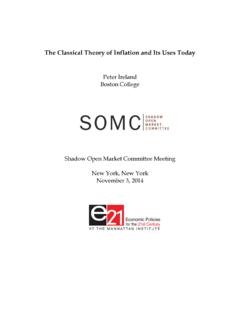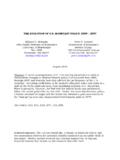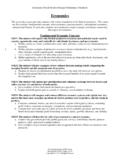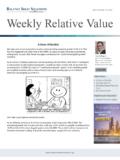Transcription of LECTURE NOTES ON MACROECONOMIC PRINCIPLES
1 LECTURE NOTES ON MACROECONOMIC PRINCIPLES Peter Ireland Department of Economics Boston College Copyright (c) 2013 by Peter Ireland. Redistribution is permitted for educational and research purposes, so long as no changes are made. All copies must be provided free of charge and must include this copyright notice. Ch 33 aggregate demand and aggregate supply Introduction Typically, increases in the labor force, increases in the capital stock, and advances in technological knowledge allow the economy to produce more and more over time. But in some years, this normal growth does not occur. These periods of declining incomes and rising unemployment are called recessions when they are relatively minor and depressions when they are more severe. What causes these short- run fluctuations in economic activity?
2 This chapter starts by presenting some facts about short- run economic fluctuations and then develops the model of aggregate demand and aggregate supply to help explain and understand those facts. Outline 1. Three Key Facts About Economic Fluctuations 2. Explaining Short- Run Fluctuations 3. The aggregate demand Curve A. Why the aggregate demand Curve Slopes Downward B. Why the aggregate demand Curve Might Shift 4. The aggregate supply Curve A. Why the aggregate supply Curve is Vertical in the Long Run B. Why the Long- Run aggregate supply Curve Might Shift C. Using aggregate demand and Long- Run aggregate supply to Depict Long- Run Growth and Inflation D. Why the aggregate supply Slopes Upward in the Short Run E. Why the Short- Run aggregate supply Curve Might Shift 5. Two Causes of Economic Fluctuations A.
3 The Effects of a Shift in aggregate demand B. The Effects of a Shift in aggregate supply Three Key Facts About Economic Fluctuations Fact 1: Economic Fluctuations are Irregular and Unpredictable Fluctuations in economic activity are often called the business cycle. But this term is somewhat misleading, since these fluctuations do not follow a regular and predictable pattern. 2 Panel (a) of Figure 1 shows that recessions are sometimes close together, as in 1980 and 1982, but sometimes farther apart, as with 1991 and 2001. Fact 2: Most MACROECONOMIC Quantities Fluctuate Together Although real GDP is the variable that is most commonly used to monitor the economy, other variables also fluctuate along with GDP: corporate profits, investment, consumption, retail sales, home sales, etc.
4 But some variables fluctuate more than others. Panel (b) of Figure 1 shows that investment spending, in particular, tends to fluctuate widely. Even though investment averages only about one- seventh of GDP, its fluctuations account for about two- thirds of the decline in GDP that takes place during recessions. Fact 3: As Output Falls, Unemployment Rises Panel (c) of Figure 1 shows that the unemployment rate rises considerably during recessions. When the recession ends and real GDP begins to grow again, the unemployment declines. But notice that the unemployment rate never falls to zero; instead, it fluctuates around its natural rate of 5 or 6 percent. Explaining Short- Run Economic Fluctuations The Assumptions of Classical Economics Recall that the classical dichotomy is the separation of economic variables into real variables, which are measured in units of physical quantities, and nominal variables, which are measured in units of money.
5 According to classical MACROECONOMIC theory, changes in the money supply affect nominal variables but not real variables. The classical idea of monetary neutrality allows us to study the determination of real variables, like output and unemployment, separately from the determination of nominal variables, like inflation. The Reality of Short- Run Fluctuations Most economists believe that monetary neutrality holds in the long run but not in the short run, and hence that changes in the money supply do have short- run effects. Even the classical economists, like David Hume, observed that changes in the money supply appear to affect output and employment in the short run. The Model of aggregate demand and supply The model of aggregate demand and aggregate supply is used by economists to explain short- run fluctuations in economic activity around its long- run trend.
6 The model focuses on the behavior of two variables: - The economy's quantity of output, which can be measured by real GDP. 3 - The economy's price level, which can be measured by the CPI or the GDP deflator. Since the first of these two variables is a real variable and the second a nominal variable, the model departs from the classical assumptions that allow these variables to be considered separately. Figure 2 illustrates the model. - The downward- sloping aggregate demand curve shows the quantity of goods and services that households, firms, the government, and customers abroad want to buy at each price level. - The upward- sloping aggregate supply curve shows the quantity of goods and services that firms choose to produce at each price level. But where do these curves come from, and why do they have the slopes shown in Figure 2?
7 The aggregate demand Curve In figure 2 and again in figure 3, the aggregate demand curve slopes down, indicating that as the price level falls, the quantity of goods and services demand rises. Why the aggregate demand Curve Slopes Downward Recall that an economy's GDP (Y) can be decomposed into four components: consumption (C), investment (I), government purchases (G), and net exports (NX): Y = C + I + G + NX For now, let's take G as being fixed by government policy, independent of the price level. Why might the demand for consumption, investment, and net exports fall as the price level rises? The Price Level and Consumption: The Wealth Effect Some of the wealth that individuals possess is held in nominal form: as money in their wallets or in the bank. When the price level falls, the real value of this wealth that is, its value in terms of the goods it can purchase rises.
8 This increase in wealth increases consumer spending, and hence also increases the quantity of goods and services demanded. Conversely, when the price level rises, the real value of monetary wealth falls, leading to a decrease in consumer spending and the quantity of goods and services demanded. The Price Level and Investment: The Interest Rate Effect When the price level falls, the real value of each consumer's money holdings rises. In response, some consumers will attempt to reduce their money holdings by purchasing more bonds. As they do so, the interest rate on these bonds will fall. 4 And when interest rates fall, firms will become more willing to borrow to finance new investment projects. Conversely, when the price level rises, the real value of each consumer's money holdings falls.
9 In response, some households will try to acquire more money by selling bonds. As they do, the interest rate of these bonds will rise. And, as the interest rate rises, firms will become less willing to borrow to finance new investment projects. Hence, as the price level falls, the demand for investment goods rises; and as the price level rises, the demand for investment goods falls. Note, too, that this interest effect can also impact on household's purchases of consumer durables, which may be bought on credit. The Price Level and Net Exports: The Exchange Rate Effect When the price level falls in the US, the US interest rate falls as well. This makes US bonds less attractive to investors, both in the US and overseas. As these investors turn to other countries' bonds as alternative, higher- yielding investments, they will sell dollars and buy foreign currencies.
10 As a result, the US dollar depreciates, that is, its value in terms of foreign currencies falls. Since each dollar buys fewer units of foreign currencies, foreign goods become more expensive than US goods. This change in relative prices affects spending both in the US and abroad. US consumers buy fewer goods from abroad, and foreign consumers buy more US goods. Both of these changes cause net exports to rise. Conversely, when the US price level rises, the US interest rate rises as well. Since US bonds become more attractive to international investors, they buy dollars and sell foreign currencies. Hence, the US dollar appreciates, that is, its value in terms of foreign currencies rises. Since each dollar buys more units of foreign currencies, foreign goods become less expensive than US goods.












